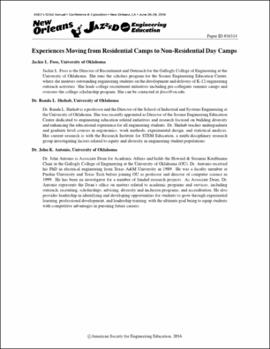| dc.contributor.author | Foos, Jackie L. | |
| dc.contributor.author | Shehab, Randa L. | |
| dc.contributor.author | Antonio, John K. | |
| dc.date.accessioned | 2021-04-19T20:34:37Z | |
| dc.date.available | 2021-04-19T20:34:37Z | |
| dc.date.issued | 2016-06 | |
| dc.identifier.citation | Foos, J. L., & Shehab, R. L., & Antonio, J. K. (2016, June), Experiences Moving from Residential Camps to Non-Residential Day Camps Paper presented at 2016 ASEE Annual Conference & Exposition, New Orleans, Louisiana. 10.18260/p.26817 | en_US |
| dc.identifier.uri | https://hdl.handle.net/11244/329210 | |
| dc.description.abstract | This paper describes a recent change in our engineering summer outreach program and how that change was enacted and perceived. Nonresidential summer camp programs are often scheduled to be delivered on successive days, meaning that the attending students interact with the camp’s curriculum, staff, and instructors daily for several consecutive days. Our College followed this model for many years, with students experiencing guided engineering activities for a block of time in the morning and a block of time after lunch. Each block was generally focused on one particular discipline-related activity. An alternate model is to schedule camp programs to be delivered one day per week over a period of multiple weeks, resulting in a weekly interaction between the students and the camp’s programming. This model was implemented for the first time during summer 2015. The camp was delivered on consecutive Fridays for a period of seven weeks and the curriculum for each Friday was designed to introduce high school rising juniors and seniors to a particular academic program in the College of Engineering. The camp was structured and marketed in such a way to allow students to register for and attend those days of interest to them and/or those days that fit within their summer schedule. During summer 2015, the total attendance across the seven days of the program was 262. This total comprised 95 individual students that attended one or more days of camp; on average, each student attended 2.8 days. Interestingly, the distribution for the number of days attended by students was bimodal and 24% of the students attended five or more days. Experiences and initial assessments of this weekly summer camp program model are described and a discussion of the advantages and disadvantages of weekly versus daily program schedules is provided. | en_US |
| dc.language | en_US | en_US |
| dc.subject | Engineering Education | en_US |
| dc.subject | Summer Camps | en_US |
| dc.subject | College of Engineering | en_US |
| dc.subject | Residential Summer Camps | en_US |
| dc.subject | Nonresidential Summer Camps | en_US |
| dc.title | Experiences Moving from Residential Camps to Non-Residential Day Camps | en_US |
| dc.type | Article | en_US |
| dc.description.peerreview | Yes | en_US |
| dc.identifier.doi | 10.18260/p.26817 | en_US |
| ou.group | Gallogly College of Engineering | en_US |
